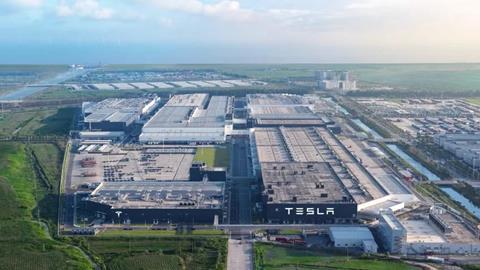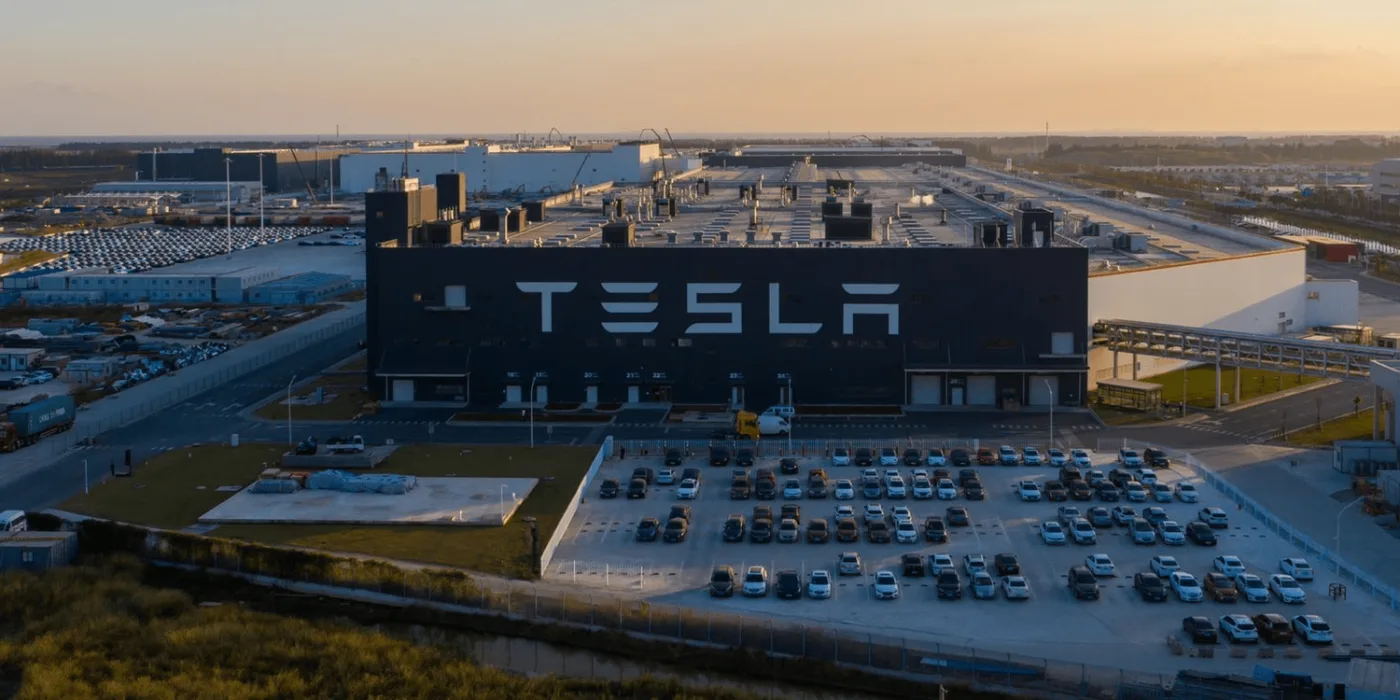Tesla’s Gigafactory in Berlin, officially named Gigafactory Berlin-Brandenburg, represents a significant milestone for the electric vehicle (EV) industry in Europe. As Tesla’s first major manufacturing facility on the continent, it plays a key role in the company’s global expansion and in meeting the growing demand for electric vehicles across Europe. However, beyond just production, Gigafactory Berlin is set to transform local economies, regional supply chains, and the overall automotive industry in Europe.

This post explores the impact of Tesla’s Gigafactory on local economies, its role in strengthening European supply chains, and how it aligns with the EU’s broader goals of sustainability and innovation.
1. Boosting Local Economies: Job Creation and Investments

Tesla’s decision to build its European Gigafactory in Germany marks a significant investment in the region. The facility is expected to create thousands of direct jobs in manufacturing, engineering, and logistics. In addition to these direct jobs, there are numerous indirect opportunities created in sectors like construction, retail, hospitality, and services. This influx of new jobs stimulates local economies, particularly in the state of Brandenburg, which had previously struggled with economic stagnation.
Key Economic Benefits:
- Job Creation: Tesla plans to employ over 12,000 workers at full production capacity, making it one of the largest employers in the region. These jobs range from assembly line positions to highly skilled engineering roles, offering employment opportunities across a wide spectrum of skill levels.
- Regional Economic Growth: The construction of Gigafactory Berlin brought significant investments in infrastructure, with Tesla and its contractors working to improve roads, energy systems, and public transportation around the facility. This has led to increased economic activity in the surrounding areas.
- Attracting New Businesses: Tesla’s presence acts as a magnet for other businesses. Suppliers, technology startups, and logistics companies are flocking to the region, creating a vibrant ecosystem around the Gigafactory.
The factory’s location near Berlin, a major European innovation hub, also provides access to a highly educated workforce, further boosting the region’s economic prospects.
2. Strengthening European Supply Chains

One of the most important roles Tesla’s Gigafactory plays is its impact on European supply chains. Before the Gigafactory’s construction, Tesla largely relied on importing its vehicles from the United States and China to meet European demand. This created logistical challenges, raised costs, and increased delivery times. By establishing a manufacturing base in Europe, Tesla is not only able to produce vehicles closer to its customers but also foster local supply chains for critical components, including batteries.
Key Supply Chain Impacts:
- Localized Production: Gigafactory Berlin produces Tesla’s Model Y vehicles and plans to include other models in the future. Localizing production reduces the company’s reliance on long-distance shipping, cutting down costs, carbon emissions, and lead times.
- Battery Manufacturing: The Gigafactory is equipped with a dedicated battery production facility. This is crucial for Tesla’s EV strategy, as batteries are one of the most expensive components of electric vehicles. Producing batteries in-house in Europe helps reduce dependency on Asian manufacturers and ensures a stable supply of high-quality battery cells.
- Supporting the Growth of Local Suppliers: The presence of Gigafactory Berlin has spurred the development of a local supplier network for Tesla. European manufacturers of auto parts, electronics, and materials are benefitting from Tesla’s procurement needs, fostering new opportunities for growth and innovation across industries.
3. Aligning with EU Sustainability Goals
Tesla’s Gigafactory aligns with the European Union’s broader sustainability goals, particularly those outlined in the European Green Deal, which aims to make Europe the first climate-neutral continent by 2050. As the EU pushes for a cleaner, more sustainable future, the adoption of electric vehicles and renewable energy solutions will be critical in reducing carbon emissions. Tesla’s presence in Europe helps accelerate this shift by increasing the availability of electric vehicles and renewable energy storage solutions.
Sustainability Contributions:
- Electric Vehicle Production: Tesla’s commitment to producing electric vehicles at scale directly supports the EU’s goal of reducing CO2 emissions from the transport sector. As more consumers transition to EVs, the demand for gasoline and diesel vehicles will decrease, contributing to cleaner air and a reduction in fossil fuel dependency.
- Battery and Energy Storage Solutions: In addition to vehicles, Tesla produces battery storage products like the Powerwall and Powerpack, which can store renewable energy generated by solar panels and wind farms. With the Gigafactory’s battery production capabilities, Tesla is positioned to contribute significantly to Europe’s renewable energy storage infrastructure.
- Eco-Friendly Manufacturing: Tesla has emphasized the environmental friendliness of its Berlin Gigafactory. The company has adopted sustainable manufacturing processes, aiming for reduced water usage, energy efficiency, and minimal emissions from the factory. Tesla’s efforts in sustainable manufacturing could set a new standard for the European auto industry.
4. Challenges and Adaptation in the European Market

While the Gigafactory Berlin brings numerous benefits, it is not without challenges. Tesla has had to navigate complex regulatory environments in Europe, as each country has its own laws regarding labor, production standards, and environmental regulations. Additionally, Tesla faces competition from established European automakers like Volkswagen, BMW, and Renault, which are rapidly developing their own electric vehicle lines to compete in the growing EV market.
Key Challenges:
- Regulatory Compliance: Tesla has faced delays and regulatory hurdles during the construction of Gigafactory Berlin, particularly related to environmental permits. The company has had to work closely with German authorities to address concerns about the factory’s water consumption and impact on local ecosystems.
- Competition: The European EV market is becoming increasingly competitive, with local automakers rapidly scaling up their electric vehicle offerings. Tesla will need to continuously innovate to maintain its leadership position in this highly competitive environment.
- Supply Chain Dependencies: While Tesla is working to localize its supply chain in Europe, it still relies on some imported components, particularly raw materials for battery production. Securing a stable and sustainable supply of materials like lithium, nickel, and cobalt will be crucial to ensuring smooth production in the future.
5. Tesla’s Future in Europe: Opportunities for Growth and Innovation

The establishment of Gigafactory Berlin represents just the beginning of Tesla’s ambitions in Europe. The company has a clear opportunity to expand its footprint in the region and drive innovation across several key areas.
Opportunities for Tesla:
- Expansion into New Markets: With Gigafactory Berlin, Tesla can serve not only Western European markets but also expand further into Central and Eastern Europe, where EV adoption is still in its early stages.
- Innovation in Autonomous Driving: Tesla’s continued development of its Full Self-Driving (FSD) technology could have a transformative impact on the European market. As autonomous driving regulations evolve, Tesla could play a key role in shaping the future of mobility across Europe.
- Renewable Energy Solutions: Beyond cars, Tesla’s energy division has the potential to make a significant impact in Europe’s energy sector. By integrating battery storage with renewable energy projects, Tesla can support the EU’s transition to a more decentralized and sustainable energy grid.
Conclusion
Tesla’s Gigafactory in Europe is more than just a car production facility—it is a catalyst for economic growth, supply chain innovation, and sustainable development. By creating jobs, fostering local supplier networks, and supporting the EU’s sustainability goals, Tesla is positioning itself as a key player in Europe’s green transition. Despite challenges related to regulation and competition, the long-term impact of Gigafactory Berlin on local economies and the European automotive landscape will be substantial, setting the stage for continued innovation and growth in the EV and renewable energy sectors.

